Residential plumbing and HVAC installers take note: you can pipe an entire home with the durability, flexibility and cost-effectiveness of PEX — for plumbing, fire sprinkler systems and radiant floor heating. Here’s how… PEX plumbing With more new homes plumbed with PEX than copper and CPVC combined, you’re probably already aware of the benefits of Read more
Guest Blog
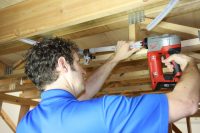
Residential plumbing and HVAC installers take note: you can pipe an entire home with the durability, flexibility and cost-effectiveness of PEX — for plumbing, fire sprinkler systems and radiant floor heating.
Here’s how…
PEX plumbing
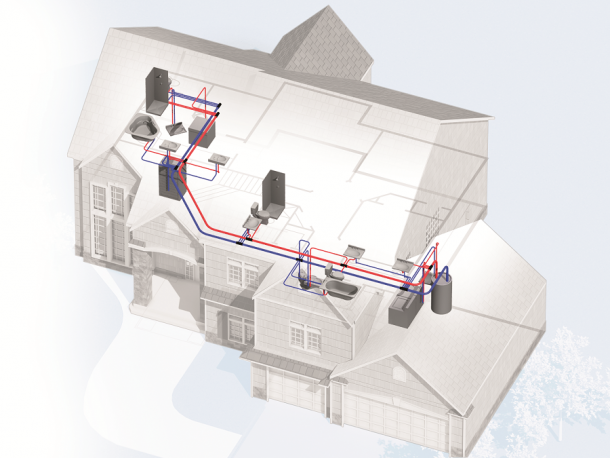 With more new homes plumbed with PEX than copper and CPVC combined, you’re probably already aware of the benefits of plumbing with PEX. However, you may not know about a newer, smarter way to install a PEX plumbing system that goes in faster, uses less materials, requires fewer connections and minimizes your liability.
With more new homes plumbed with PEX than copper and CPVC combined, you’re probably already aware of the benefits of plumbing with PEX. However, you may not know about a newer, smarter way to install a PEX plumbing system that goes in faster, uses less materials, requires fewer connections and minimizes your liability.
This innovative design is called Logic plumbing.
The Logic approach uses the flexibility of PEX pipe to minimize connections and reduce potential leak points while also incorporating multiport tees located near fixture groupings to limit the amount of pipe and connections needed.
What’s a multiport tee, you ask? It’s essentially a bunch of tees all molded together to create one long tee with multiple outlets. This design greatly reduces the number of fittings and connections needed to plumb a home (think: reduced materials cost and labor time).
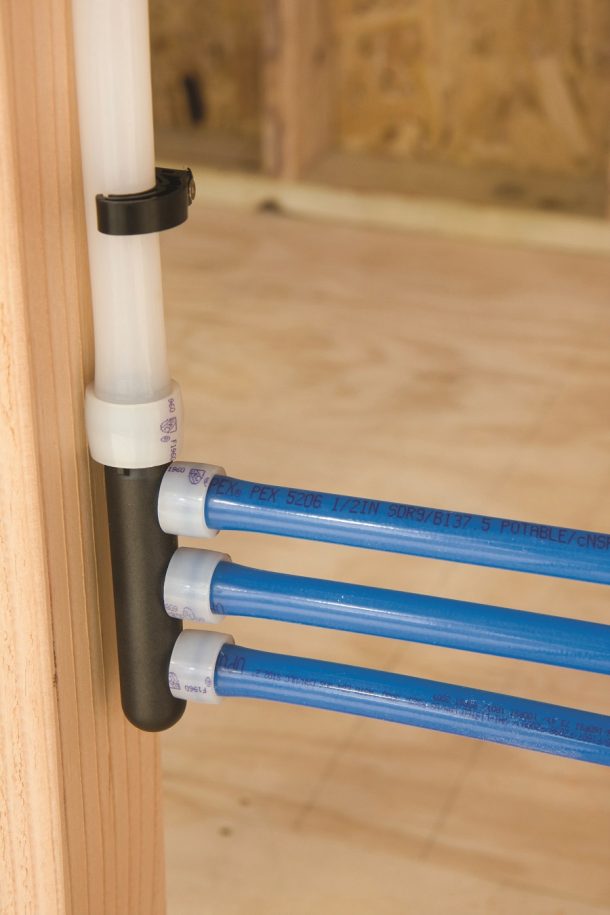 Here’s an example of how a multiport tee saves installation time and materials: a flow-through multiport tee with six outlets has eight connections (six connections for the ports, a main flow-through inlet and a main flow-through outlet). Six regular tees, on the other hand, have a whopping 18 connections. That’s an increase of more than double the connections — and double the installation time.
Here’s an example of how a multiport tee saves installation time and materials: a flow-through multiport tee with six outlets has eight connections (six connections for the ports, a main flow-through inlet and a main flow-through outlet). Six regular tees, on the other hand, have a whopping 18 connections. That’s an increase of more than double the connections — and double the installation time.
Best of all, multiport tees are not considered manifolds, so they can be installed behind walls without the need for an access panel. Double win, there!
For a Logic layout, a main line connects to a multiport tee with distribution lines going out from the multiport to provide water to all fixtures in a single or adjacent grouping. This design uses significantly less pipe than a home-run layout, with just a few more connections. Plus, it requires considerably fewer connections compared to a trunk-and-branch installation.
For example, a 2,300-square-foot, two-story home using a Logic design requires only 637 feet of pipe while a home-run system uses 1,515 feet of pipe. And, while it’s true a Logic installation uses slightly more connections than a home-run layout (59 vs. 48 in the 2,300-square-foot, two-story home example), the amount of pipe savings is significantly more beneficial with the labor and material savings you get with less pipe to install.
A Logic layout also installs much faster compared to a trunk-and-branch system due to the vast reduction in connections. With the two-story home example, a Logic layout uses a mere 16 fittings and 59 connections compared to a whopping 96 fittings and 165 connections for trunk and branch.
PEX multipurpose fire sprinkler systems
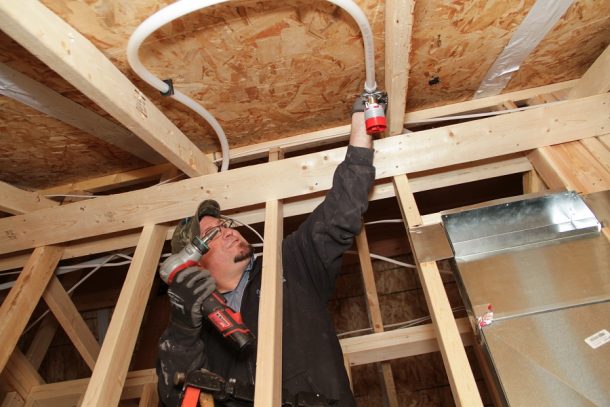 If you’re a licensed plumber who wants to add an additional service to your offering, check out PEX multipurpose fire sprinkler systems. These systems combine the fire sprinklers with a home’s cold-water plumbing. It’s genius!
If you’re a licensed plumber who wants to add an additional service to your offering, check out PEX multipurpose fire sprinkler systems. These systems combine the fire sprinklers with a home’s cold-water plumbing. It’s genius!
Installation is remarkably easy — the sprinkler is essentially just another fixture to tie into the plumbing line. For most contractors who already install PEX plumbing systems and have the tools, knowledge and, most importantly, the relationships with the home builders, this is a slam dunk.
Depending on the jurisdiction, multipurpose systems typically don’t need check valves or backflow preventers, and because they combine with the potable plumbing, they don’t use antifreeze, so all those added costs are eliminated.
To get started in most jurisdictions, licensed plumbers just need the appropriate training and a quality design that meets the NFPA 13D standard requirements for home fire sprinkler systems.
If you’re interested in learning more, email me at kim.bliss@uponor.com, and I can get you all the information you need to add this profitable new service to your business.
PEX hydronic radiant floor heating
There’s nothing like the comfort of radiant floor heating — ask anyone who has experienced it. And, homeowners will pay nicely for a quality radiant floor heating system, so there is definitely income potential if you can learn to do it right.
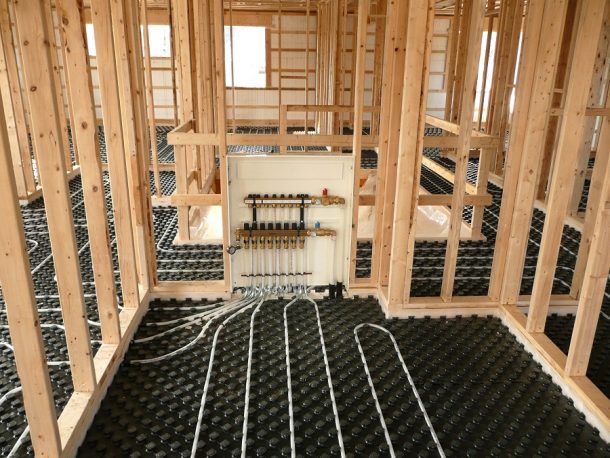 That said, with radiant floor heating, there’s a little more to learn. But, like fire sprinkler systems, starting with a proper design is key. If your design is wrong in the beginning, there’s not much you can do to fix the system once it’s installed.
That said, with radiant floor heating, there’s a little more to learn. But, like fire sprinkler systems, starting with a proper design is key. If your design is wrong in the beginning, there’s not much you can do to fix the system once it’s installed.
Take advantage of the radiant design services many PEX manufacturers offer to guide you through the process. There are several design factors to know, including floor R-values, heat-loss calculations, pipe sizing, loop lengths, pump sizing, manifold types and more.
Once you learn the basics of radiant design and get a few small jobs under your belt, you have the potential to take your expertise to the next level with bigger, more profitable projects. But again, be sure to get the proper design and training before you tackle a radiant project. It will be well worth it in the long run.
To get a jumpstart on all things radiant, visit the following industry websites at radiantprofessionalsalliance.org, healthyheating.com or heatinghelp.com.

Kim Bliss is the content development manager at Uponor. She can be reached at kim.bliss@uponor.com.

The term “duct tape” is misleading in that it’s not just one kind of tape (and, ironically, the majority aren’t recommended for HVAC systems). The term generally applies to a classification of pressure-sensitive tapes constructed in three layers: polyethylene (plastic), scrim (mesh fabric) and rubberized adhesive. But the quality, thickness (measured in mils — 1 Read more
 The term “duct tape” is misleading in that it’s not just one kind of tape (and, ironically, the majority aren’t recommended for HVAC systems). The term generally applies to a classification of pressure-sensitive tapes constructed in three layers: polyethylene (plastic), scrim (mesh fabric) and rubberized adhesive. But the quality, thickness (measured in mils — 1 mil = 1/1,000 in.), adhesion level and tensile strength vary widely, as do the specific recommended uses for each sub-category. Knowing which tapes to grab for which jobs will ensure your fix doesn’t fail and can save you time, money and a lot of space in your toolbox. Here’s a rundown.
The term “duct tape” is misleading in that it’s not just one kind of tape (and, ironically, the majority aren’t recommended for HVAC systems). The term generally applies to a classification of pressure-sensitive tapes constructed in three layers: polyethylene (plastic), scrim (mesh fabric) and rubberized adhesive. But the quality, thickness (measured in mils — 1 mil = 1/1,000 in.), adhesion level and tensile strength vary widely, as do the specific recommended uses for each sub-category. Knowing which tapes to grab for which jobs will ensure your fix doesn’t fail and can save you time, money and a lot of space in your toolbox. Here’s a rundown.
General Purpose Duct Tapes
Typical Thickness: 6-9 mils
This category covers a range of duct tapes, from the DIY junk-drawer tool for everyday household repairs to pro grade duct tapes that offer slightly thicker polyethylene, stronger adhesive qualities and, in some cases, waterproof backing. General purpose utility tapes have excellent bang for your buck and offer basic performance levels for jobs around the house (like sealing boxes, patching a grill cover or mending a plastic garden tool) or light duty pro applications in which an abundance of tape will be used and discarded in a short time (like hanging poly-sheeting or moisture barriers and bundling jobsite materials to be scrapped). Manufactured in a wide array of colors, they can also come in handy for labeling and color-coding. Because these tapes generally aren’t designed to stick to rough surfaces or withstand extreme fluctuations in temperatures, they’re best in lower-demand applications when you need a lot of tape at a value price. Bottom line: Handy for DIY home projects or light duty patching and bundling for pros on the job site.
Heavy Duty Duct Tapes
Typical Thickness: 10-17 mils
Unlike general purpose tapes, heavy duty duct tapes are formulated with superior adhesive, extra-thick polyethylene and an interwoven fabric scrim that has high tensile strength—but they’re still easy enough to tear by hand, which makes them ideal for fast repairs on the job. They can adhere to a variety of rough (and in some cases dirty) surfaces like brick, concrete, metal, wood and vinyl siding without the corners peeling up. Many offer UV resistance so that sunlight won’t impact their performance over time, and they can stand up to extreme temperature ranges and weather conditions. These are aggressive, highly versatile tapes for on-the-job tasks like attaching plastic sheeting to exterior surfaces, securing power cables and other tripping hazards on dirty floors or bundling construction materials. As a bonus, they can save the day in unexpected worksite mishaps — mending a broken tool handle, sealing a cracked wet/dry vacuum cleaner hose, or even patching a hole in your work boot or a torn truck seat. Bottom line: Every tradesperson should keep at least one roll of heavy duty duct tape in the toolbox — and multiple widths or colors won’t hurt.
Clear Repair Tapes
Typical Thickness: Approx. 7 mils
Clear repair tapes are not technically duct tapes in construction, but they offer similar performance and application, so it’s natural to compare them. Plus, they’re valuable tools for pros. Designed primarily for non-porous surfaces like glass, fiberglass or plastic, these tapes have long-lasting, airtight holding power, are waterproof and UV-resistant and, most importantly, allow the surface underneath to show through. That makes them ideal for repairing cracked cell phones screens, skylights, windows, mirrors and headlights. Bottom line: Your go-to tape for airtight, waterproof repairs on any surface that needs to be seen.
Structural Grade Duct Tapes
Typical Thickness: Approx. 17 mils
This is a relatively new category in tape technology. Super-aggressive adhesion and extremely high tensile strength make tapes like this less a tool for mending and patching and rather a quick engineering solution. Structural grade duct tapes are for projects that require intense strength, durability and holding power: think hoisting a heavy tool bucket up scaffolding, towing heavy construction materials short distances, or strapping and securing a heavy tool or appliance for transport. Currently, only one product exists in this category—T-Rex® Brute Force™. One loop of it can hold more than 700 pounds (yes, 700), making it the strongest duct tape on the market. It’s so strong you can’t tear it by hand. For some jobs, it’s even strong enough to take the place of rope or chain (and a roll of Brute Force is significantly lighter and more compact). Bottom line: Job requires a rope or chain? Consider a roll of Brute Force instead.

Steven Wagner is an eight-year veteran of ShurTech® Brands, Wagner currently serves as Category Manager for T-REX® and DIY Tapes. He has played an integral role in the development of the T-Rex® tape brand and has spearheaded advancements in new and innovative tape solutions for the contractor and residential markets. Wagner holds a bachelor’s degree from Capital University and a master’s degree from the University of Akron.

Rinnai supports skilled trade gap by partnering with Folds of Honor The skilled trade industry is in desperate need of enthusiastic workers as the baby boomers are retiring. However, vocational school has become an obsolete term for high school students, the exact age employers are targeting the most.Skilled Trade Gap Baby boomers are beginning to Read more
Rinnai supports skilled trade gap by partnering with Folds of Honor
The skilled trade industry is in desperate need of enthusiastic workers as the baby boomers are retiring. However, vocational school has become an obsolete term for high school students, the exact age employers are targeting the most. Skilled Trade Gap
Skilled Trade Gap
Baby boomers are beginning to retire and recruiters are looking for new skilled trade workers to fill their shoes. What is the problem? There are not enough laborers equipped to fill them. With a push toward a four-year college degree, many generational skilled trade workers are leaving the family business, and only a few men and women are choosing trade career options.
Vocational school is soon left out of the conversation when teenagers are told that going to a four-year institution would provide them with a more reliable and better paying career. Even though vocational school is less expensive, provides students with a valuable skill, and most students are hired immediately into the workforce upon completion. Knowing these statistics, teenagers made the decision to go to college which created a large gap between themselves and the current baby boomers in the industry.
There are 31 million skilled trade positions needing to be filled, according to Adecco US. It is important to reopen the conversation and benefits of vocational school with high school students as well as introduce them to these ideas as soon as the word “college” is mentioned.
How Can We Help?
Rinnai is dedicated to helping close the skilled trade gap by encouraging more students to seek a vocational education. By partnering with Folds of Honor, a nonprofit organization started by Major Dan Rooney, Rinnai will be providing trade-specific educational scholarships to spouses and children of America’s fallen and disabled service members. For every Rinnai tankless water heater or boiler sold this year, Rinnai will make a contribution up to $250,000 to fund scholarships in the plumbing and HVAC trades. We hope our contribution will help to strengthen our industry for the current generation to provide skills for the future.
We encourage you to join Rinnai by honoring our service members’ sacrifice and educating their legacy, by donating to Folds of Honor, by visiting https://www.rinnai.us/FoldsOfHonor.

Forced air is still the traditional method of heating homes, but radiant heat is gaining significant momentum as an alternative. According to HGTV, the growth rate of in-floor radiant heating systems was estimated at 30 to 50 percent per year. At the heart of this shift is not just one single benefit. It’s a variety of advantages Read more
Forced air is still the traditional method of heating homes, but radiant heat is gaining significant momentum as an alternative. According to HGTV, the growth rate of in-floor radiant heating systems was estimated at 30 to 50 percent per year.
At the heart of this shift is not just one single benefit. It’s a variety of advantages that radiant floor heating systems bring to the table, the combination of which enhance the daily lives of a home’s occupants:
Even Heat Distribution
When a house is heated by a forced-air system, it will always be warmest near the vents that distribute the air. This can lead to “hotspots” on one end of a room while the other side of the room remains cool. And because hot air rises, upstairs rooms will be warmer than those downstairs.
With radiant floor heating systems, homeowners control how heat circulates in their home. Rather than heating the surrounding air, the heat that radiates from the floor warms other objects in the room and is evenly distributed without the potential for heat loss.
Improved Air Quality
While air pollution is more often associated with the outdoors, indoor air can be dirty as well. Whether it’s dust, pet dander or chemicals from fragrances (among other sources) that pollute the air, forced-air systems exacerbate the problem for allergy sufferers. That’s because the forced, heated air will stir up and mix with these airborne particles.
Since radiant floor heating systems don’t move air to deliver heat, the circulation of indoor particles is minimized. With less pollutants blown around, indoor air quality improves, which benefits allergy sufferers.
No Ductwork
The ductwork in forced-air systems further contributes to air pollution. When it’s riddled with cracks and holes, more dust and odors can enter and circulate. Without proper insulation, these same cracks and holes can cause air to leak out of the system and hinder its overall efficiency.
With no ducts, radiant floor heating systems reduce the churn of dust and allergens while curtailing heat loss. The absence of ducts means less work for homeowners as it eliminates the need for repairs like cleaning out ducts clogged with particles or adding insulation when heat loss mounts.
Energy Savings
With their uneven distribution of heat and potential for heat loss, traditional heating systems can be energy hogs.
Depending on how well a house is insulated, radiant floor systems can save up to 30 percent compared to forced-air systems. In terms of bills, the impact is quite significant as space heating is the largest energy expense for the average U.S. home, accounting for around 45 percent of energy bills.
Noiseless Operation
Homes should be quiet, but forced-air systems can be noisy as furnaces cycle on and off, gaps in the ductwork whistle and loose parts rattle.
By comparison, radiant floor heating systems are exceptionally quiet.
As consumers learn more about the advantages of radiant heating, its popularity will continue to grow.
 Josh Quint is product manager, heating and cooling, for Viega LLC.
Josh Quint is product manager, heating and cooling, for Viega LLC.

It’s easy to become overwhelmed when thinking about the Internet of Things (IoT) and the complexities of smart home appliances and products. However, it’s never too late to educate yourself on the smart HVAC features and products that are sought by today’s customers. Before the dawn of the smart age, HVAC controls were synonymous with Read more
It’s easy to become overwhelmed when thinking about the Internet of Things (IoT) and the complexities of smart home appliances and products. However, it’s never too late to educate yourself on the smart HVAC features and products that are sought by today’s customers.
Before the dawn of the smart age, HVAC controls were synonymous with a simple thermostat that provided comfort from a system designed to focus only on heating or cooling a space. Functionality and practicality were the most vital roles of an HVAC system. With the increased role that technology plays in our daily lives, a lot has changed.
It’s no secret that smart home technology has reshaped the way consumers interact with their homes on a day-to-day basis. Now more than ever, consumers demand the ability to change their home’s climate with the push of a button or a simple voice command – without ever touching the thermostat and from anywhere, whether sitting on a couch or away on vacation. The focus has gone from practicality to the accessibility and convenience that come with an integrated smart HVAC system. Simply put, consumers demand more from their HVAC systems.
 Considering this smart home revolution, technology advancements have allowed for HVAC systems to evolve faster than can be absorbed by those in the field who must explain the functionality of the systems they are selling. How can one fully learn and understand the value of today’s smart HVAC? Dedicated time to learn about this rising tide of technology is important, but equally as helpful is to install and use similar HVAC-connected smart products within your own home. First-hand experience and determining how it can benefit your life will simplify explaining the value proposition to customers.
Considering this smart home revolution, technology advancements have allowed for HVAC systems to evolve faster than can be absorbed by those in the field who must explain the functionality of the systems they are selling. How can one fully learn and understand the value of today’s smart HVAC? Dedicated time to learn about this rising tide of technology is important, but equally as helpful is to install and use similar HVAC-connected smart products within your own home. First-hand experience and determining how it can benefit your life will simplify explaining the value proposition to customers.
While the smart home revolution has markedly changed the products, services, and accessibility HVAC dealers can offer, making the sale comes back to the homeowner’s perceived financial outlay and return on investment. Knowing how to explain the value in energy savings and diagnostic capabilities throughout the life of the product can help make the case for the more costly, higher efficiency system. Similarly helping consumers understand the value of convenience from a connected systems, such as voice interactions through Alexa, or even Geofence-based set points through the app, are paramount to moving customers up to a connected system.
It also provides an avenue to become a trusted advisor for your customers while building lifelong relationships for not only yourself, but also for the brands you’re selling. While a robust consumer value proposition is key to making the initial sale, the long term value to a contractor of a connected customer is even more impactful. Using remote diagnostic capabilities, servicing dealers can better maintain the customer relationship over time, deliver more efficient service when required, and be in the best position for a proactive replacement at the end of the product lifecycle.
By being transparent and showcasing factors such as energy savings, user experience, cross-device capabilities, etc. dealers can leverage the smart home revolution to position themselves as knowledgeable and trustworthy.
Because smart home technology has reshaped the way HVAC systems are viewed within the greater home ecosystem, it should be noted that not everyone (or every home) is right for a smart HVAC installation. Consumers often do their own research before consulting dealers about whether a technologically advanced HVAC system is right for their home. In the end, an educated consumer can be the best barometer for whether upgrading to a smart HVAC system makes the most sense.
 George Land, Connected Home Solutions General Manager for Ingersoll Rand Residential HVAC
George Land, Connected Home Solutions General Manager for Ingersoll Rand Residential HVAC
